Our top priority is to provide you with a unique best-quality culture-based guided tour in English or any language of your choice without the hassle of being taken to various factory outlets or shopping stops along the way!
Our Ephesus tours from Kusadasi port are personalized for individuals and groups, offer you the flexibility and the comfort as well as the expertise and convenience of a guided tour without the rigidity or crowds of a bus tour and are particularly ideal for cruise ship passengers who come to Kusadasi port.
You will be picked up in Kusadasi by your tour guide and the driver by a comfortable tour vehicle suited to the size of your party. The ride from Kusadasi to Ephesus takes about 20-30 min.
Ephesus has the largest collection of Greek and Roman ruins in the eastern Mediterranean; it is estimated that only 15-20 per cent of it has been unearthed.
Immerse yourself in the rich and complicated history. Marvel at the the depth of its culture and the spectacular architecture as you stroll down the Marble Street, enjoying highlights such as the Library of Celsus which contained 12,000 scrolls at its prime and the 25,000-seat Great Theatre.
Witness the prosperity of the city first hand by visiting the Terrace Houses, located on the hills as well as many ruins of posh shops along the Curete Street. Picture yourself sitting on one of the seats of Odeon which was used for both council meetings and concerts and enjoy the atmosphere of democracy.
House of the Virgin Mary, purportedly the last home of Mary, is a Catholic and Muslim shrine located on Mt. Nightingale about 7 Km (4 miles) from Selcuk. Fill up your bottles or directly take some sips from the 3 taps of mountain water representing wealth,health and fertility respectively. If time allows it, a short tour will take you to the ruins of Temple of Artemis, Basilica of St. John’s Church, Isabey Mosque in Selcuk and if you wish, a stop to grab a bite at local eateries.
 All pickups and drop offs are included in our tours at your convenience.
All pickups and drop offs are included in our tours at your convenience.
 Your appreciation and satisfaction with our best-quality Kusadasi Private Tours to Ephesus for.
Your appreciation and satisfaction with our best-quality Kusadasi Private Tours to Ephesus for.
Just relax and have fun in our exclusive and unique private tours!
 Take a Private Full Day Ephesus Tours to the ruins of Ancient city of Ephesus
Take a Private Full Day Ephesus Tours to the ruins of Ancient city of Ephesus Visit the Ephesus, House of Virgin Mary, Temple of Artemis and Basilica of St. John”
Visit the Ephesus, House of Virgin Mary, Temple of Artemis and Basilica of St. John” Transport by Private De-Luxe Cars.
Transport by Private De-Luxe Cars. Private Local Licensed Guide.
Private Local Licensed Guide. Enjoy authentic Turkish cuisine.
Enjoy authentic Turkish cuisine. Take a half day trip to the ruins of Ancient city of Ephesus
Take a half day trip to the ruins of Ancient city of Ephesus Visit the Ephesus and Temple of Artemis
Visit the Ephesus and Temple of Artemis Transport by Private De-Luxe Cars.
Transport by Private De-Luxe Cars. Private Local Licensed Guide.
Private Local Licensed Guide. Enjoy authentic Turkish cuisine.
Enjoy authentic Turkish cuisine. Take a Private Full Day Ephesus Tours to the ruins of Ancient city of Ephesus
Take a Private Full Day Ephesus Tours to the ruins of Ancient city of Ephesus Visit the Ephesus, Terrace Houses, House of Virgin Mary, Temple of Artemis and Basilica of St. John”
Visit the Ephesus, Terrace Houses, House of Virgin Mary, Temple of Artemis and Basilica of St. John” Transport by Private De-Luxe Cars.
Transport by Private De-Luxe Cars. Delicious Lunch and Turkish appetizers & Bottle of local wine or any kind of local drinks at lunch.
Delicious Lunch and Turkish appetizers & Bottle of local wine or any kind of local drinks at lunch. Take a Private Deluxe Tours to the ruins of Ancient city of Ephesus
Take a Private Deluxe Tours to the ruins of Ancient city of Ephesus Visit the Ephesus, Terrace Houses and House of Virgin Mary
Visit the Ephesus, Terrace Houses and House of Virgin Mary Transport by Private De-Luxe Cars.
Transport by Private De-Luxe Cars. Private Local Licensed Guide.
Private Local Licensed Guide. Delicious Lunch and Turkish appetizers & Bottle of local wine or any kind of local drinks at lunch.
Delicious Lunch and Turkish appetizers & Bottle of local wine or any kind of local drinks at lunch. Half private tours to the ruins of Ancient city of Ephesus and House of Virgin Mary
Half private tours to the ruins of Ancient city of Ephesus and House of Virgin Mary Visit the Ephesus and House of Virgin Mary”
Visit the Ephesus and House of Virgin Mary” Transport by Private De-Luxe Cars.
Transport by Private De-Luxe Cars. Private Local Licensed Guide.
Private Local Licensed Guide. Enjoy authentic Turkish cuisine.
Enjoy authentic Turkish cuisine. Personalized Assistance to the disabled people is provided when requested.
Personalized Assistance to the disabled people is provided when requested. Special vans, wheelchairs and assistans are provided upon request in advance. Furthermore, vans are designed with wide aisles and comfortable seats.
Special vans, wheelchairs and assistans are provided upon request in advance. Furthermore, vans are designed with wide aisles and comfortable seats. Technological applications for accessibility are available for disabled persons.
Technological applications for accessibility are available for disabled persons. Take a half day trip to the ruins of Ancient city of Ephesus the great cities & Terrace Houses ( Houses of the rich.) used from the 1st century to 7th century AD.
Take a half day trip to the ruins of Ancient city of Ephesus the great cities & Terrace Houses ( Houses of the rich.) used from the 1st century to 7th century AD. Visit the Ephesus and Terrace Houses (Slope Houses) “
Visit the Ephesus and Terrace Houses (Slope Houses) “ Transport by Private De-Luxe Cars.
Transport by Private De-Luxe Cars. Private Local Licensed Guide.
Private Local Licensed Guide. Enjoy authentic Turkish cuisine.
Enjoy authentic Turkish cuisine. Take a Private half day tour to the ruins of Ancient city of Ephesus
Take a Private half day tour to the ruins of Ancient city of Ephesus Visit the Ancient city of Ephesus and Sirince Village
Visit the Ancient city of Ephesus and Sirince Village Transport by Private De-Luxe Cars.
Transport by Private De-Luxe Cars. Private Local Licensed Guide.
Private Local Licensed Guide. Enjoy authentic Turkish cuisine at Sirince village.
Enjoy authentic Turkish cuisine at Sirince village. Enjoy the one of the most beautiful fruit wine made in Sirince village.
Enjoy the one of the most beautiful fruit wine made in Sirince village. Half Day Private Ephesus and Kirazli Village Tours
Half Day Private Ephesus and Kirazli Village Tours Visit the Ephesus, Temple of Artemision, Kirazli Village and Steam Train Museum”
Visit the Ephesus, Temple of Artemision, Kirazli Village and Steam Train Museum” Transport by Private De-Luxe Cars.
Transport by Private De-Luxe Cars. Private Local Licensed Guide.
Private Local Licensed Guide. Enjoy authentic Turkish cuisine at Kirazli village.
Enjoy authentic Turkish cuisine at Kirazli village.
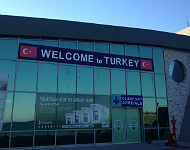

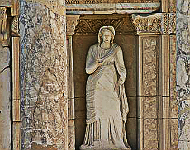
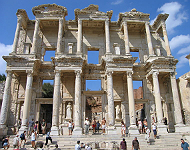
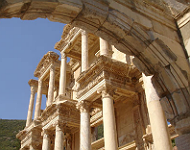
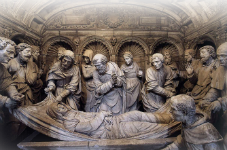


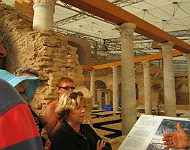
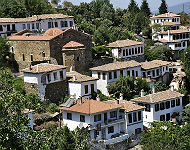

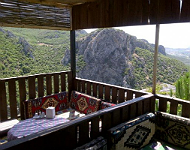


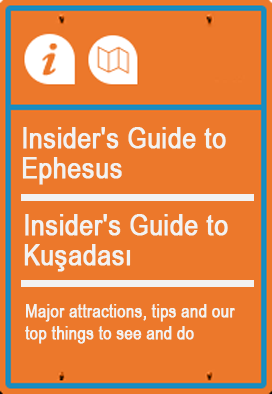








Must See in Ephesus Tours From Kusadasi
Ephesus Tours From Kusadasi
EPHESUS TOURS FROM KUSADASI GOOGLE MAP
View Larger Map
Ephesus ( Historical Notes)
The first traces of occupation of the area where the city of Ephesus later stood date back to 5000 B.C. During the Bronze Age, the hill called Ayasoluk (from Haghios Theologos) was already the site of a fortified settlement; it was probably the site of Apasa, mentioned in Hittite sources of the mid-2″‘1 millennium, from which the Hellenized name Ephesus would have derived.
Only a few individual tombs remain of the Minoan settlement and the Mycenaean emporium which were founded here. Numerous legends flourished in antiquity on the birth of Ephesus, but the most popular myth attributed its foundation to the hero Androclus, son of King Codros of Athens, to whom the oracle had predicted that he would have founded a city guided by a fish and a boar.
After many wanderings, Androclus arrived at a locality in Asia Minor, running into some fishermen who were cooking fish. While he was with them, some burning coals fell out of the hearth and onto a nearby bush, waking up a boar that, as it fled, indicated the site of the future city to the hero. In reality, there is very little information on Ephesus in the Archaic Age; generally speaking, it is believed that Ionic-speaking peoples coming from the West settled in the region in around 1100 B.C., at first remaining separate from the native inhabitants.
In the place where Artemision later rose, there had originally already been a sacred area dedicated to the ancient local goddess, the Great Mother of nature, men and animals, and plant life, who was assimilated by the Greeks into Artemis. In the most ancient period, the population had settled around this sacred area, as well as in the plain that stretched at that time as far as the sea, and in the saddle between the city’s two high spots. These three settlements, populated by peoples of different origins but now inhabiting together, would allegedly form the first city of Ephesus. In around 700 B.C., the city, which had become a member of the Ionian League (a confederation of Asian Ionian cities whose center was in the sanctuary of Poseidon on the peninsula of Mycale), progressively consolidated its position in the Meander Valley and successfully fought off an attack by the Cimmerians, an Asian tribe related to the Scythians who had invaded Asia Minor, bringing death and destruction. By the 6″1 century B.C., Ephesus had become a place of great cultural and philosophical development.
In around 560 Croesus, the king of Lydia, after imposing his hegemony over the city, promoted the creation of the first large marble temple dedicated to the goddess Artemis, which incorporated and replaced more ancient buildings of worship that had stood on the site since the 8″‘ and 7″‘ centuries B.C. At the same time, the Greek population was forced to abandon the fortified city on the northern slopes of Mount Pion and to integrate with the indigenous population in a single settlement situated around the sanctuary. The hegemony of the kingdom of Lydia over Ephesus did not last long: when Croesus was defeated by Cyrus in 546 B.C., Ephesus, like all the cities of the Ionian League, fell into Persian hands, but unlike the other cities, it did not later take part in the Ionian revolt that ended with the destruction of Miletus in 494 B.C. After the Persian wars, Ephesus was a member of the Delian-Attic League, maintaining its autonomy from both Athens and Sparta; from 386 B.C. it returned under Persian rule, up until the time of Alexander the Great. After Alexander’s death in 323 B.C., the city became the object of the disputes of his successors: ruled first by Antigonos Monoph-thalmos, after 301 it fell under the control of Lysi-machus of Thrace. Lysimachus planned a new city, intending it to be the capital of his kingdom, moving the site from the plain to the area between Mounts Pion and Coressus (today’s Panayir and Bulbiil Dag). The new city was laid out according to Hellenistic urban planning rules, with a regular plan and impressive defensive walls enclosing a vast area, almost certainly never completely occupied. Considerable stretches of the walls built by Lysima-chus remain along the entire edge of the two high lands. Two gates have been identified, the one called «Magnesia», in the saddle between the hills, and the one below the northern slopes of the Biilbul Dag, through which the sanctuary of Artemis was reached.
Among the characteristics of this new city, worthy of mention is the creation of two agorai, one for commercial use and the other for civil and political purposes of the ancient urban layout, only the street running between the city’s two high points, Cu-retes Street, called Embolos in antiquity, was preserved. Until the king’s death, the new foundation was called Arsinoeia, named after his wife, Arsinoe. The Battle of Corupedium (near Magnesia ad Sipylum, or the present-day Manisa, on Mount Sipylus) in 281 A.D. brought the death of Lysimachus and turned the city over into the hands of the kings of Syria, the Seleucids, with an interval from 246 to the end of the century during which it was under the power of the Ptolemies, the kings of Egypt.
After the defeat of the Seleucids in the Battle of Magnesia in 190 B.C., the Romans forced Antiochus III, with the peace treaty of Apa-mea (188 B.C.) to surrender the territory of Asia Minor, as far as the Taurus mountain chain, to the Attalids, the kings of Pergamon. After about sixty years, Ephesus came definitively under the possession of Rome in 129 B.C., as per the testamentary instructions of Attalus III, the last king of Pergamon.
The rapacity and injustice of the Roman government during the Republic were among the reasons for the hate that developed against the new rulers, and for the enthusiasm with which, in 88 B.C., Ephesus joined the revolt of Mithridates VI, king of Pontus, which brought about the slaughter of 8,000 of the Italic population residing in the territory.
In 86, Sulla took back the city and punished it by revoking its freedom, which was not restored until the mid-1st century. B.C. Caesar went there in 48 B.C., after the Battle of Pharsalus and his victory over Pompey. Later Marc Antony did also, in the year 41 to obtain money from the province, and then again in 34-33, together with Cleopatra. With the advent of Augustus, the city enjoyed a long, stable period of tranquility and prosperity and became, in 29 B.C., the seat of the Roman governor of the province of Asia. The cultural and economic growth of Ephesus, which became one of the chief metropolises of the ancient world, continued to increase during the 2,M| century A.D. The Roman city copied and extended the Hellenistic layout: the main axis consisted of the great colonnade, 500 meters long, which led to the harbour.
Another porticoed street, called Stoa of Damianus (after a 2nd-century A.D. sophist who had designed its layout), joined the city with the Temple of Artemis. Numerous other streets such as the so-called «Marble Street*, flanked by porticoes, fountains nymphaea, and baths, enriched the urban layout of the imperial Roman Age.
The decline started, in parallel with that of the entire eastern part of the empire, with the failure of the security at the eastern borders and with the progressive decrease in trade, to which, for Ephesus in particular, was added the slow silting up of the gulf because of the silt deposits from the Caystros River. Nevertheless, the city enjoyed a considerable historical and monumental importance even during the Christian Age, when churches were erected on Ayasoluk Hill, where, according to tradition, the tomb of St. John the Evangelist was located, between the harbour and the hill of the archaic temple, the «Double Church» of St. Mary. Ephesus was the site of the third Ecumenical Council, and in 395 it became part of the Eastern Empire until the 14th century, when it was conquered by the Selcuk Turks (1375). Then, from 1426, it became part of the Ottoman Empire.
The archaeological excavations, carried on by 0. Benndorf, the first director of the Austrian Archaeological Institute, began in April 1895 and have continued in successive campaigns up to the present day.
Ephesus Kusadasi Port
THE ARTEMISION
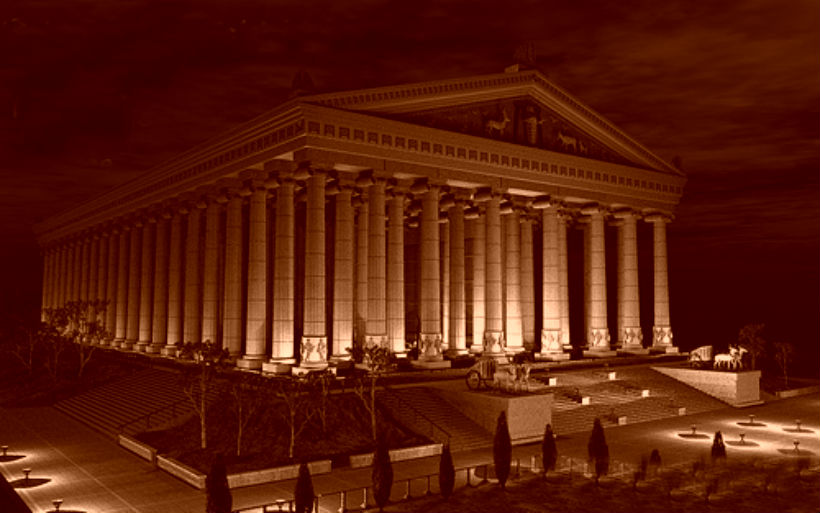
When the Ionian peoples landed in the Caystros plain, they found the sacred area dedicated to a female deity who represented the local aspect of the great Anatolian goddess, the Mother, the lady of fertility, vegetation, life, and death. The Greeks, although they lived separately from the natives at first, introduced into the sanctuary the gods they had brought with them from their homeland, so that the area held various cult buildings, which date from the 8″‘ and 7th century B.C. In around 560 B.C., King Croesus engaged Chersiphron of Knossos, his son Metagenes and Theodoras of Samos to erect a large temple to the ancient goddess, whom the Greeks had by then associated with the goddess Artemis, and who had remained, or had become once again, the dominant deity of the sanctuary.
The study of the various building phases of the sanctuary is not simple, because of the total destruction of the part above ground and the presence of a water-bearing layer below, which must be continually emptied with a draining pump.
The Archaic Temple
The temple ordered by Croesus was an exceptional work of colossal proportions, with a stylobate measuring 55.10 x 115.14 meters, making it the largest in the Greek world and, what is more, the first monumental building constructed entirely of marble. The building was dipteral, without an opisthodomos, and various theories have been suggested as to the arrangement of the columns, of which no traces remain, but which was followed, in the general layout, in the subsequent Hellenistic Age temple. The archaic temple already had the characteristic, like the Didyma temple of Miletus, of having the bottom part of the columns engraved with figures. According to Pliny, there were 36 columnae celatae, and fragments of them have been found, one of which has an inscription on its base with a dedication to Croesus, confirming the words of Herodotus (I, 92), who stated that the king offered the sanctuary «the golden heifers and most of the columns.
The Hellenistic Temple
According to the ancient accounts, the temple was destroyed by a fire, set by a madman named Herostratus in 356 B.C., on the same night Alexander was born. The fire caused great damage, because the ceiling of the temple was made of wood; we also know that Alexander, before leaving for the expedition against the Persians, made a sacrifice amidst the temple ruins and offered to shoulder the costs for the rebuilding, an offer which was courteously turned down by the Ephesians.
The new temple, whose architect was Cheirokrates (or, according to another interpretation, Dinokrates, Alexander’s architect), was erected on the foundations of the previous one, with the difference that it was raised by 13 steps, while the archaic building had a rather low platform, which was inadequate for the weak nature of the soil. There was the same number of new columns with reliefs as in the previous version; according to the most common interpretation of a passage by Pliny the Elder [Nat. Hist, XXXVI, 21, 95), the height must have reached 18.40 meters, and one of the columns was allegedly carved by Scopas, the famous sculptor born on Paros, who lived between 420 and 340 B.C. The peristasis kept, on the wings, the dipteral arrangement of the older building (with two rows of columns), but the western facade now had three rows of columns. An examination of coins has made it possible to establish that the front pediment was decorated with sculptures and a graphic reconstruction has been attempted. It is this temple of the 4″‘ century B.C. that was considered one of the seven wonders of the ancient world, and which Pliny called «the light of Asia». The entire sanctuary must have contained many other sculptures and paintings also; according to the Greek scholar Strabo, Praxiteles was believed to have worked on the altar. The richness of the donations made to the goddess also made the sanctuary one of the region’s most important economic and banking centers.
The Altar
Opposite the temple’s facade, therefore to the west of it, there had been an altar since the archaic period, but the structure we know best is that of the Hellenistic-Roman Age. It was a large rectangular construction, accessed from the western side, which occupied an area of 32 x 22 meters, and it was covered with marble relief slabs, one of which depicted an Amazonomachy. The altar was decorated by columns against the wall outside and a portico inside.
The Cult Image
We do not know what the very ancient cult statue was like, but we know that the one from the classical and Roman Age was made of wood (sources give different indications as to the kind of wood: cypress, oak, elm), and only the face, hands, and feet were visible, blackened by the use of oil; in fact, in the copies carved out of colored marbles or in paintings, these parts are shown in black. The iconography of the Artemis Ephesia is very particular, but not unique in Asia Minor. The goddess is always shown frontally, with her arms at her sides, her forearms outstretched, and her feet together. Her head is veiled, and she is wearing a cylindrical headpiece, the polos, which may take the shape of a crown of walls or, during the Imperial Age, that of a small decorated temple. At the sides of her face is a sort of nimbus, with rows of lion and griffin protomes, which seems to have been the representation, carried to the frontal side, of an original decoration of the part of the garment that hung on the back of the head. The high part of the breast-piece sometimes has symmetrical little Nikai figures, below which is the element that has caused the most debate, i.e., several rows of ovoid protuberances, differently arranged depending on the period: in rows, in a semicircle, or in a triangle. The most common explanation is that they are breasts, originally intended as real, and later just a decorative element, used as a symbol of fertility.
Other theories, also deriving from the fact that these elements are usually not shaped like real female breasts, have included bee eggs, dates, and planets. One last interpretation identifies them instead as bull testicles, hung from the statue on the occasion of sacrifices.
The Clergy
Heading the clergy of Artemis was a high priest, called «Mega-byzus» and wearing a characteristic priest’s costume, rendering evident the ancient eastern origin. The priestess of Artemis also had an important role, and likewise the person in charge of decorating the goddess. Among the associations of a sacred nature, worthy of mention were the Curetes, who re-enacted the drama of the birth of the goddess each year in the sacred wood of Ortygia. A sacred college was made up of women who were addressed with the title «Melissa», meaning bee, a symbol that is found on the coins of Ephesus and in the decoration of the garments of the cult statue, and which reconnects with the fertility symbols.
Our group of four had the pleasure of having Gokhan show us Ephesus, the Terrace Houses, and The House of Virgin Mary. What a great tour. Gokhan is fantastic and very friendly and did a great job being our guide. We saw some amazing places and it was highlight of the trip. We were picked up from Kusadasi cruise port and they were early and waiting for us. Great company!
Kusadasi Ephesus Excursions
I loved this private Ephesus tour from Kusadasi!
From online travel reviews we found Ephesus Tours and booked a private Ephesus tour. We were picked up at the hotel at 7:15 Am by our guide Yesim and the driver Ahmet.
This tour was absolutely amazing in many aspects. First of all, it was completely customized to our needs which included a Chinese/English speaking tour guide and a wheelchair for my little girl who sprained her ankle at the beginning of this trip. Secondly, it totally satisfied our hunger for detailed information on Ephesus’s long history which was a great challenge by any scale and yet our guide Yesim did a wonderful job fulfilling that. Lastly, although it was a long half-day tour, it was well-organized and well-paced that we were able to visit both the House Virgin Mary and Ephesus ruins without having to struggle with the crowds of tourists from cruise ships.
We just so loved this private Ephesus tour!
Yvonne Wang
Ephesus tours from Kusadasi was Fabulous !
Great experience walking around the back streets of Kusadasi. Food in out of the way restaurants was amazing. The Ephesus was outstanding. So much more to see.